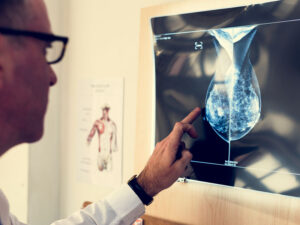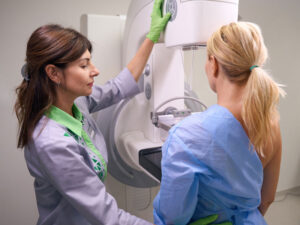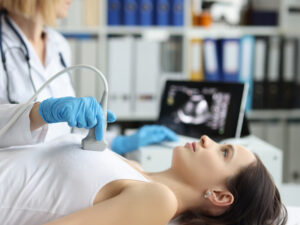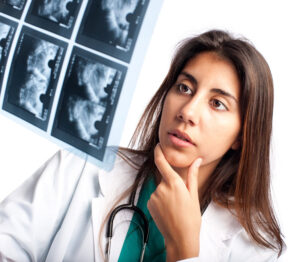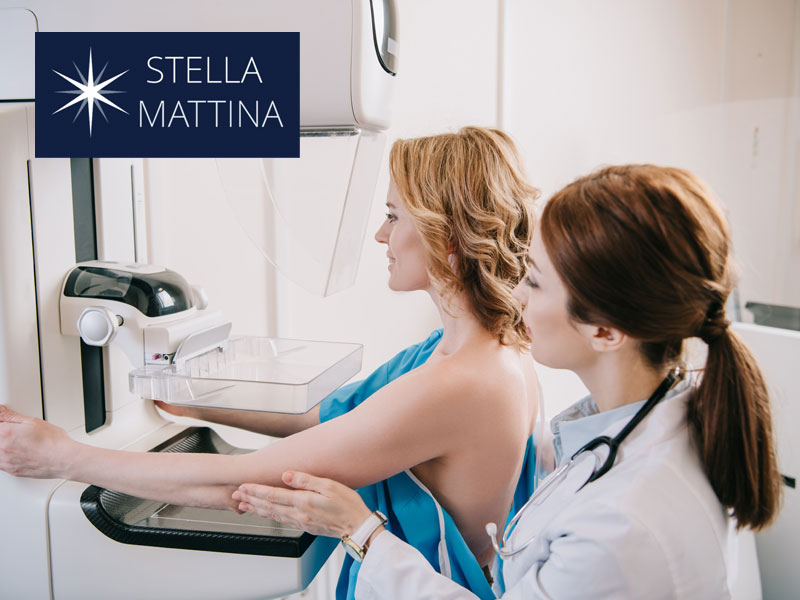
You’ve probably heard about October Breast Cancer Awareness every year. The aim is to increase awareness, promote education, and encourage early detection of breast cancer through regular screening mammograms.
There’s a good reason: Breast cancer is one of the most common women’s cancers. But early detection through breast cancer screening, particularly mammograms, can play a crucial role in changing this, improving outcomes, and saving lives.
As part of our commitment to promoting prevention and excellence in women’s care, we’ve gathered a complete guide to breast cancer screening. We want you to be able to make informed decisions about your health.
Keep reading to learn about breast cancer screening tests, mammogram procedures, screening guidelines, the risks and benefits for your health, and the importance of early detection. Let’s start by understanding what a mammogram clinical breast exam is.
Table of contents
The Mammogram Procedure
What to Expect During a Mammogram
Types of Mammograms: 2D vs. 3D
When Should You Have a Mammogram?
What Can Influence Breast Screening Results?
Breast Cancer on Ultrasound or MRI
Benefits and Risks of Breast Cancer Screening
The Mammogram Procedure
A mammogram is a specialized X-ray used to detect abnormalities in your breast tissue, such as lumps or tumors, that may indicate breast cancer.
What to Expect During a Mammogram?
When you go for a mammogram, the process typically lasts about 20 minutes. The nurse asks you to change into a gown, and you’ll need to remove any jewelry or clothing above the waist.
A radiologic technologist will then position your breast on a special X-ray machine with a flat surface and another plate that presses down on your breast from above.
This compression helps spread out the breast tissue for a clearer view and reduces radiation exposure. Compression is necessary to get the best image and may cause some discomfort or pressure, but it should only last a few seconds.
Each breast will be compressed from top to bottom and side to side to capture images from different angles. The entire process is quick and usually well-tolerated.
Results:
After the procedure, the images will be sent to a radiologist, who will review them for any signs of abnormalities or breast cancer.
You may get your results within a few days, depending on the facility. If the radiologist sees anything that may indicate breast cancer, you might be called back for additional tests or follow-up imaging.
Types of Mammograms: 2D vs. 3D
There are two main types of mammograms: 2D (traditional) mammograms and 3D mammograms (also known as digital breast tomosynthesis). Here’s how they differ:
2D Mammograms
A standard mammogram that takes two images of each breast, one from the top and one from the side. The images are flat, meaning all layers of your breast tissue are compressed into a single image.
3D Mammograms (Tomosynthesis)
An advanced mammogram that captures multiple images of your breast from different angles, creating a three-dimensional picture of the breast tissue.
It’s especially useful for women with dense breast tissue, as it reduces the likelihood of false positives and offers greater accuracy in detecting small abnormalities that could evolve into breast cancer.
When Should You Have a Mammogram?
It depends on your risk factors for breast cancer, health history, age, and health organization guidelines. So, discuss your situation with your healthcare provider to determine the best age for you to begin screening.
But in general, for most women, the recommendation is to start annual or biennial mammograms between the ages of 40 and 50. However, if you’re at higher risk for breast cancer due to family history, genetic predisposition, or other factors, you may need to start earlier.
Age Guidelines
Various health organizations provide guidance on when and how often you should receive mammograms, but they don’t always agree with each other. In addition, the guidelines often evolve according to:
- Advances in breast cancer research
- Understanding breast cancer risk
- Individual risk factors and preferences
- Benefits versus risks of breast cancer screening
Today, most organizations aim to strike a balance between the benefits of early breast cancer detection and the risk of overdiagnosis (more on this below, when we discuss the risks and benefits).
For reference, here are the current recommendations from the American Cancer Society (ACS):
- Women aged 40 to 44 have the option to start annual screening with mammograms.
- Women aged 45 to 54 should get mammography screening every year.
- Women 55 and older can switch to mammograms every two years or continue yearly mammograms.
While many health organizations suggest stopping mammograms around age 75, this recommendation is influenced by your overall health and the benefits versus risks of continued screening to find breast cancer.
The American Cancer Society does not set a specific age for stopping mammograms but recommends that women continue screening as long as they are in good health and have a life expectancy of 10 years or more.
And – as we’ll mention in a moment – screening too early can lead to false positives.
Why are Screening Tests So Effective?
Regular breast cancer screenings, particularly mammograms, are highly effective in detecting cancer in its early stages. They can identify tumors or abnormalities in the breast tissue that are often too small to be felt during clinical breast exams.
In fact, mammograms can find breast cancer up to two years before you can feel a lump. This significantly improves your chances of successful treatment and reduces your chances of dying from breast cancer.
What Can Influence Breast Screening Results?
While mammograms are generally reliable for detecting breast cancer early, several factors can influence the accuracy of screening results. One of the most common issues is breast density.
Breast density refers to the amount of fibrous or glandular tissue compared to fatty tissue in your breasts. Dense breasts have more glandular and connective tissue, which can make it harder for mammograms to find breast cancer.
On a screening mammogram, dense tissue appears white, and so do many tumors, making it difficult to distinguish between normal and abnormal areas.
Women with a high breast density are also at a slightly higher risk of developing the disease. This combination of a higher risk of breast cancer and reduced mammogram sensitivity means that women with dense breasts may need additional screening methods like ultrasounds or MRIs to ensure any abnormalities are caught early.
Shedding light on this factor, the American Food and Drug Administration (FDA) has recently required that all mammogram reports must include information about breast density, classifying them as dense and not dense.
In addition to breast density, other factors may influence mammogram results, including the following:
- Age: Younger women tend to have denser breast tissue. As women age, their breast tissue generally becomes less dense, improving mammogram accuracy.
- Hormonal Factors: Hormone replacement therapy (HRT) and certain medications can also affect breast tissue density, which may influence mammogram readings.
- Prior Surgeries or Scars: Previous breast surgeries, including biopsies or breast augmentation, can alter the appearance of breast tissue on a screening mammogram, making it harder to get an accurate result for breast cancer.
If you have high breast density or other factors that may affect screening mammography results, or if you notice anything different during breast self-exam, it’s important to discuss additional screening options with your healthcare provider.
Supplementing screening mammography with ultrasounds or MRIs can help detect abnormalities that might otherwise go unnoticed.
Breast Cancer on Ultrasound or MRI
Both ultrasounds and MRIs are helpful tools in supplementing mammograms for finding breast cancers, particularly for women with high breast density or those at higher risk.
If you receive a positive result for cancer after clinical breast exams and screening mammography, your doctor may ask you to have one of these alternative screening tests to confirm or discard your results. Here’s what to expect from each:
Ultrasound
An ultrasound uses sound waves to create images of the inside of your breast. It often follows after a mammogram if your results showed something unusual. Ultrasounds are non-invasive and painless, and they help distinguish between solid masses (which could evolve into cancer) and fluid-filled cysts (which are typically benign).
MRI
A breast MRI (Magnetic Resonance Imaging) uses strong magnets and radio waves to create detailed images of the breast. Doctors use it with women at high risk of breast cancer, such as those with a strong family history or genetic predisposition (like the BRCA mutation).
MRIs can detect small tumors that screening mammograms or ultrasounds might miss, but they’re usually used alongside other screening tests because they are more sensitive and can sometimes detect non-cancerous abnormalities, leading to false positives for breast cancer.
Benefits and Risks of Breast Cancer Screening
There’s no doubt screening mammograms play a critical role in the early detection of breast cancers, offering less invasive treatment options and decreasing your chances of dying from breast cancer.
However, like any medical procedure, screening comes with both benefits and risks. Understanding these can help you make informed decisions about your health.
Let’s dive into the benefits and risks of breast cancer screening, so you can discuss them with your doctor and make the best decision to meet your individual needs.
Benefits of Breast Cancer Screening
Early Detection
Screening mammograms can find breast cancer early, often before symptoms like lumps or pain appear. Early detection significantly increases your chances of successful treatment and decreases breast cancer mortality.
Studies show that early-stage breast cancers have a 5-year survival rate of over 99%, compared to later stages, meaning the earlier you find the disease, the less your chances of dying from this cancer.
Improved Treatment Options
Detecting breast cancer early can lead to less aggressive treatments. In the early stages, you may be able to avoid more invasive procedures like mastectomy and chemotherapy, opting instead for targeted therapies, lumpectomies, or radiation.
Increased Survival Rates
Regular mammograms are directly linked to higher survival rates. Women who get regular screening mammograms are 30% less likely to dying from breast cancer than those who don’t.
This is, again, because screening mammography catches cancers when they’re smaller, less aggressive, and more treatable.
Risks of Breast Cancer Screening
False Positives
A false positive occurs when a mammogram detects something that looks like cancer but is not. These findings can lead to unnecessary stress, further tests (such as biopsies or additional imaging), and sometimes even unnecessary treatments.
False positives are more common in younger women and those with dense breast tissue. Unfortunately, about 10% of women who undergo a mammogram will receive a false positive result, according to the American Cancer Society.
Overdiagnosis
Overdiagnosis refers to the detection of cancers that are so slow-growing or non-aggressive that they would not have caused harm during your lifetime. Some of them would even disappear naturally.
However, these cancers are often treated with surgery, radiation, or chemotherapy, even though they may not have required any intervention.
This may lead to unnecessary treatments, side effects, and long-term physical and emotional consequences. Research suggests that around 10% of breast cancers diagnosed through screening may be over-diagnosed.
Radiation Exposure
Mammograms use low-dose radiation to capture images of breast tissue. While the radiation exposure from a single mammogram is minimal, repeated exposure over time could slightly increase breast cancer risk, particularly in younger women.
False Negatives
In some cases, mammograms may fail to detect cancer, resulting in a false negative, which can delay diagnosis and treatment, and lead to the cancer advancing to a more serious stage.
How to Balance the Risks and Benefits?
Discussing your personal risk factors with your healthcare provider can help determine the right screening schedule for you.
Women with higher risks, such as those with a family history of breast cancer, may benefit from starting screenings earlier or combining mammograms with additional tests like MRIs or ultrasounds. Women with lower risk or older age may opt for less frequent screenings.
Being informed about both the benefits and risks empowers you to make a decision that aligns with your health goals and personal preferences.
Bottom line
Regular cancer screening tests, particularly through mammograms, have a profound impact on public health, contributing significantly to the early detection and reduction of mortality rates associated with breast cancer.
By identifying cancer at earlier, more treatable stages, mammograms save lives and promote greater awareness of breast health, helping you to take proactive steps in managing breast cancer risks.
Breast Cancer Screening and Awareness with Stella Mattina
At Stella Mattina, we’re dedicated to helping you stay proactive about your breast health.
In addition to breast self-exam, you can count on our expert team to help you access cancer screening mammography for possible cancers.
Whether you’re due for your routine mammogram or need guidance on treatment options, take control of your breast health and schedule an appointment today at a time that suits.
Dr. Krum is currently in practice in Arlington, TX. He received his undergraduate degree at Texas A&M University, then attended UTMB Galveston for medical school, finishing in 1986, completing his residency there in 1990. Providing a full range of obstetrical and gynecological care, he specializes in the treatment of endometriosis and robotic surgery. He arranges his schedule so that same-day appointments are usually available.
